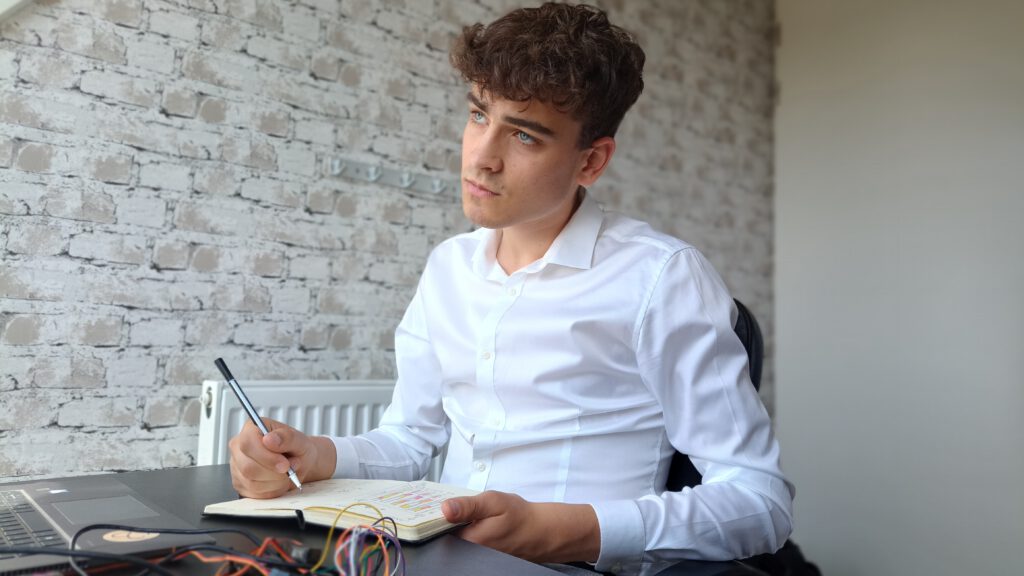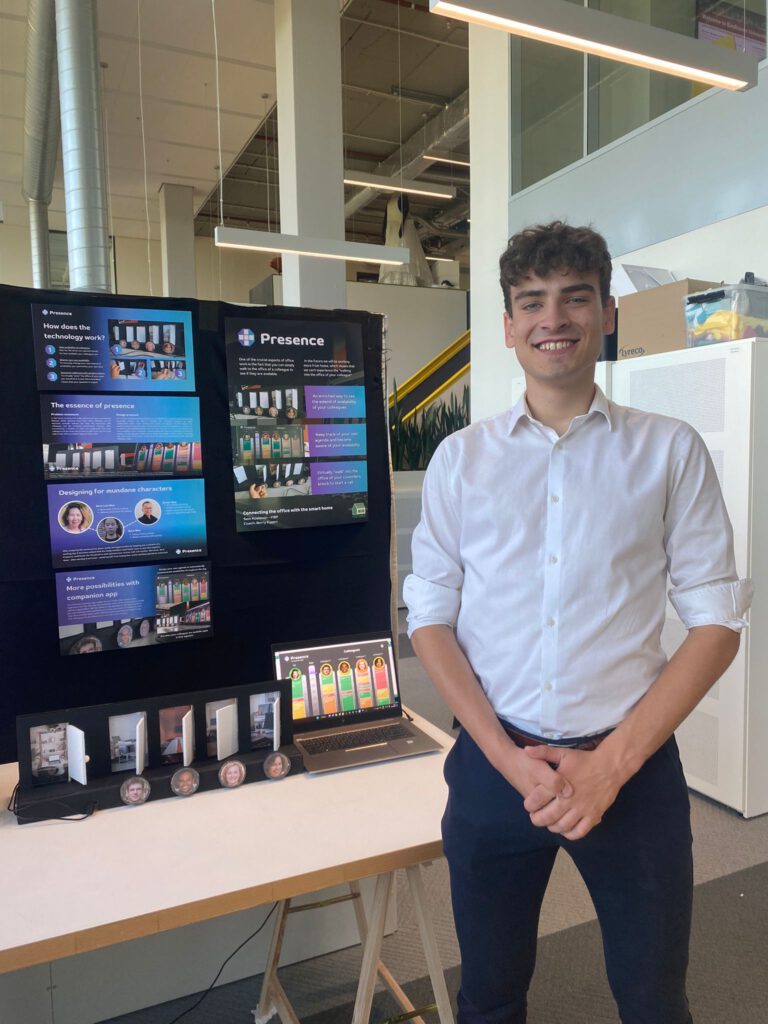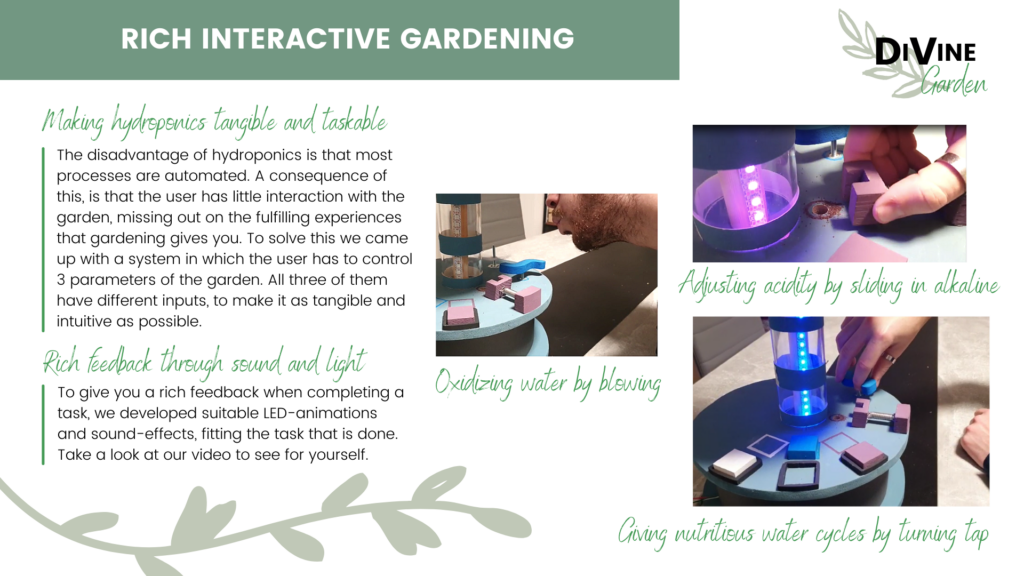
This is me
My name is Sem Koelewijn. I am 20 years of age, currently in my third and last year of the Bachelor’s Industrial Design and fantasize about what the future will look like: New technologies, new ways to live with technology and new possibilities for people to enhance their quality of life through technology.
Within my time at the TU Eindhoven, I want to develop my designing skills in such a way that I will become capable to put my vision of the future into practice. Through developing my understanding of the iterative design process – ideation, conceptualization, visualization, iterative prototyping and user validation – I hope to achieve this. The Bachelor’s of Industrial Design helped me to develop these capabilities.
Professional Identity
A project leader
To start off, I like project work. Setting goals and working in a group together to achieve these goals is something that energizes me. I excel in my design activities when the goal of the project is defined clearly. Furthermore, I am capable of melting together (design) visions of group mates into one synthesis while keeping in mind the bigger scope of a project. With my capability of planning, sense of responsibility and spirit to strive for quality, I tend to see myself as an adequate leader in projects. Determining when to go for the (qualitatively better) long option or the (quickly iterative) pragmatic option during a design process is something I am learning continuously.
“The high standards I set help me to always strive for the best. On the other hand there is little room for trial-by-error, which (ironically) is integral to any design process. Balancing out quality and pragmatism (such as rapid iteration) is one of the main challenges I face in my project,,
The ever continuing design process dilemma
A versatile designer
As elaborated later in my vision, I believe that the power of a designer lies within their ability to connect with both the users/society and engineers that develop the technology at the same time. A versatile skillset, across all of the expertise areas of Industrial Design, is pivotal in this situation. Throughout my Bachelor’s I have been working to develop these expertise areas equally. Despite my broad skillset, I especially excel in the expertise area’s of Business and Entrepreneurship and User and Society. This closely relates to my vision, since I believe that design can be economically viable if applied correctly and innovation is from utmost importance to keep up with the changing world/demands of people. For the sake of a versatile personal development, I still aspire to develop myself on the aspect of Technology and Realization. More can be read about this on the future scoping page.

An entrepreneur and presenter
My holistic design vision and my earlier described designer profile – both personal characteristics, talents and interests, as well as my design related capabilities – fit an entrepreneurial picture. My attention for detail in the presentation my products, concepts and ideas provides an aspect of professionality to the engaging sales pitch that I am able to deliver. This resonates with my vision: the presentation can make or break a design. Giving a presentation/demonstrator a slick, cohesive visual identity (through e.g. brand design) can provide the “wow-factor” to a design.
With a profile that is becoming clearer and clearer throughout my study and a great interest for tech-entrepreneurship, I currently envision myself as a directing figure in a company that designs innovative, sustainable technology with regard to user experience, to ultimately improve the standard of living of people. My vison as a designer can be linked to this.
Various design disciplines
My vision and previously described profile resonate with some of the design disciplines where my interests lie: Interaction Design, (digital) UX/UI Design and Brand Design.
On the aspect of Interaction Design, I feel the design should always revolve around humans. Getting validation through user testing is necessary in order to determine whether the actions of the interaction are well coupled to the information that the artifact communicates through feedback and feedforward [3]. My user centered design mindset and capability to do user research stem from this vision.
In my internship at MedApp in my third year I worked as a UX/UI designer. This discipline of design correlates well with my personality. As elaborated earlier, I like to see result quickly, I am often pragmatic and simply like to put things on the shelf. Therefore operating in the tangible/visible phase of a design process suits me better than operating in the often conceptual/abstract ideation phase. In contrast to embodied design, UX/UI design enables to design digitally via Figma or Adobe XD. Digital design, barely needing resources and being time/cost friendly in comparison to physical prototyping, allows for rapid high fidelity prototyping, enabling in-depth exploration of a variety of design possibilities in little time (figure 1). It therefore fits my way of working very well, so I was able to design multiple new app functionalities during my intership.

Lastly, I believe that good brand design creates an opportunity to give a wow-factor to designed products and services. Throughout the projects I have done in my Bachelor, I have been responsible for the “branding” of the products in question. This entails making a logo, slogan and corporate identity. I feel that this is necessary to make design look professional. This professionality is from utmost importance to be able to attract investors/buyers for your design.
Vision
(Industrial) designers shape the future. Through their ability to melt together different pieces of information, such as scientific desk research, user testing, market analysis and different design opinions into tangible design concepts, they are the drivers of innovation and creativity. Designers have a key position in orchestrating a design process, taking the right steps, using the right methods to make the right design decisions at the right moment in a design process.
A designer can be valuable for a company because of their knowledge of both user and market, as well as how it translates to technology. I believe that fitting the product in the market, and making it resonate with the needs of the customer is the most important aspect about design. Design is human-centered. I believe that there are multiple aspects to take into account when practicing user centered design. Three of these aspects overarch my vision of human-centered design, cohesiveness fitting to brand design, intuitiveness fitting interaction design and minimalism correlating with UX design and eco-friendly design.
First and foremost, I believe that design should be cohesive. By creating a corporate identity, both through brand design (e.g. logo design, graphical design) and product design that has cohesion, a firm can (when done correctly) achieve a level of professionality, create a wow-factor for possible users and stakeholders, and even achieve rememberability [5]. An example of cohesive brand and product design done correctly is with Apple (see figure 2). Every generation of products aesthetically fit together in a product family. Their great attention for consistent brand design pedestals that.

Second, design should make sense intuitively. Information the design communicates in terms of feedback and feedforward, as described in Interaction Frogger [3], should fit the action that a user takes. Providing information to the user in the right manner can make or break a design. An example of rich physical interaction can be seen in my Project B2.1 (see figure 3).

Third, I believe that design should be minimalistic. Obviously, keeping a design simple, minimalistic in functionality and aesthetics (minimizing design “noise”), benefits the usability [1]. For me however, the term “minimalistic design” can be interpreted a lot broader: in my opinion, minimalism is not only about how a design looks or what it can do. I believe designers have a responsibility to combat the mass consumption society, advocating a minimalistic way of living to the world through their designs. Therefore product design should be more durable, with replaceable components and recyclable. I realize that design for the masses takes resources from the earth. Designers have a responsibility to minimalize the depletion of the earth.
Conclusion
Within a the process of innovating, a designer has a bird-eye view of the design process because of their versatile skillset across different expertise areas. The most important takeaway from my vision is that I want to make design that matters: design that really makes a positive impact on people’s daily lives. This can be achieved by designing human centrically. As elaborated earlier, this translates to multiple dimensions (minimalism, cohesiveness and intuitiveness).
References
- Fessenden, T. 2021. Aesthetic and Minimalist Design (Usability Heuristic #8). Nielsen Norman Group. https://www.nngroup.com/articles/aesthetic-minimalist-design/
- O’hayon, J. 2017. space black case Apple Watch, silver MacBook Pro, jet black iPhone 7 Plus, and silver iMac with corresponding boxes. Unsplash. https://unsplash.com/photos/Bs-zngH79Ds
- S. A. G. Wensveen, J. P. Djajadiningrat, and C. J. Overbeeke. 2004. Interaction frogger: a design framework to couple action and function through feedback and feedforward. In Proceedings of the 5th conference on Designing interactive systems: processes, practices, methods, and techniques (DIS ’04). Association for Computing Machinery, New York, NY, USA, 177–184. https://doi.org/10.1145/1013115.1013140
- TU/e – Technische Universiteit Eindhoven. (n.d.). Studiegids Industrial Design TU/e
- Wheeler, K. 2022. Brand Identity: How to Develop a Unique & Memorable Brand in 2023. https://blog.hubspot.com/agency/develop-brand-identity
